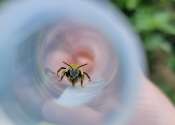Bilbies could hop back into mild climate zones, study finds
Bilbies bred in a sanctuary in Dubbo have provided researchers with vital clues about how they would fare in temperate Australia where they once thrived.

Bilbies bred in a sanctuary in Dubbo have provided researchers with vital clues about how they would fare in temperate Australia where they once thrived.
Plants & Animals
14 hours ago
0
49

Peatlands store more carbon per square meter than any other ecosystem on Earth. These waterlogged, mossy bogs beat even dense rainforests for their ability to act as carbon reservoirs.
Ecology
11 hours ago
0
14

The arid desert oasis is an important agricultural production base in northwestern China, and desert reclamation is the main reason for its continuous expansion. However, the effects of long-term conventional agricultural ...
Agriculture
May 9, 2024
0
1

Research published in the journal Weed Science shows that drill-interseeded cover crops into vegetative growth stage 3 (V3) corn performs well in Northeast U.S. production regions. The paper is titled "Light partitioning ...
Agriculture
May 9, 2024
0
9

The saturated soil conditions predicted to result from increased rainfall in the UK's upland regions could have a knock-on effect on the ambition to create more woodland in the fight against climate change, a new study has ...
Plants & Animals
May 9, 2024
0
5

For years, both scientists and farmers have debated whether the use of cover crops—plants used to cover the ground after harvesting of main crops—have a positive or negative impact on subsequent crop yield. Hundreds of ...
Agriculture
May 7, 2024
0
20

How well bees tolerate temperature extremes could determine their ability to persist in a changing climate. But heat tolerance varies between and within populations, so a research team led by Penn State entomologists examined ...
Plants & Animals
May 6, 2024
0
39

Mountain meadows are unique ecosystems. A research team led by the Technical University of Munich (TUM) has now discovered that climate change reduces the humus content as well as the nitrogen stores in the grassland soils ...
Earth Sciences
May 3, 2024
0
1

Hadeda ibises (Bostrychia hagedash) are one of the most familiar species of birds across sub-Saharan Africa. They are large, long-legged birds with long, thin beaks for probing invertebrates out of soil, and though they appear ...
Plants & Animals
May 3, 2024
0
11

A group of crop systems analysts at Wageningen University and Research, in the Netherlands, has found evidence that intercropping on Mars could be a viable option for optimizing vegetable production.
Soil is a natural body consisting of layers (soil horizons) of mineral constituents of variable thicknesses, which differ from the parent materials in their morphological, physical, chemical, and mineralogical characteristics. It is composed of particles of broken rock that have been altered by chemical and environmental processes that include weathering and erosion. Soil differs from its parent rock due to interactions between the lithosphere, hydrosphere, atmosphere, and the biosphere. It is a mixture of mineral and organic constituents that are in solid, gaseous and aqueous states. Soil particles pack loosely, forming a soil structure filled with pore spaces. These pores contain sol solution (liquid) and air (gas). Accordingly, soils are often treated as a three state system. Most soils have a density between 1 and 2 g/cm³. Soil is also known as earth: it is the substance from which our planet takes its name. Little of the soil composition of planet Earth is older than Tertiary and most no older than Pleistocene. In engineering, soil is referred to as regolith, or loose rock material.
This text uses material from Wikipedia, licensed under CC BY-SA